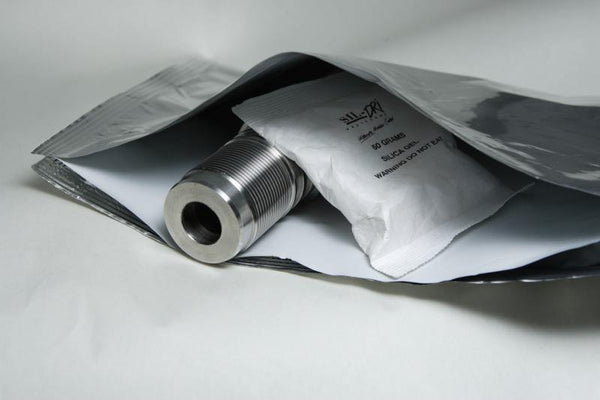
How much silica gel should I use?
Unfortunately, the answer is not always black and white, but here we will show how you can best calculate how much silica gel you should use to keep corrosion at bay.
First a little about silica gel. What is it and how does it work? Wikipedia says that "Silica gel is an amorphous and porous form of silicon dioxide, consisting of an irregular three-dimensional framework of alternating silicon and oxygen atoms with nanometer-scale voids and pores." In good Norwegian, it means that the pearls have a lot of cavities in the surface which gives a large surface area, actually up to 750-800 m2/g! The large surface area and cavities mean that silica gel attracts most liquids via adsorption. In other words, there is no chemical reaction, only mechanical forces. This makes silica gel safe to use for the vast majority of purposes and is also the reason why it is the universal desiccant that everyone knows.
The most common is white silica gel, which we stock in bags from 3g up to 2.5kg. Self-indicating silica gel changes color as it becomes saturated with moisture. We stock self-indicating silica gel in both 4kg buckets and 25kg pails .
Calculation of desiccant
Silica gel absorbs more than 30% of its own weight in moisture, and can lower the relative humidity in a closed container down to less than 2%. In practice, these values are not achieved, at least not simultaneously. We must simplify by limiting the purpose to stopping corrosion by keeping relative humidity (RH) below 40%.

Calculation of the amount of silica gel depends on the storage/transport time and the packaging's ability to prevent water vapor from penetrating the product. All packaging, container walls etc let water vapor through to varying degrees. You must therefore find this throughput number (WTR) in a table and calculate the area of all the walls (A) as well as how long to store (T). Remember to add any initial moisture that is in the goods you are going to pack. Actually, you should also correct for the climate you will be storing in, but in the assumptions we choose to see this as a normal sea voyage.
- Find the area A[m2] of all the walls of the container
- Find the moisture transmission number WTR
- Find the transport time T[day]
- (WTR for 0.2mm plastic = 0.4)
- (WTR for standard aluminum foil = 0.05)
- Silica gel amount [g] = (WTR x A x T) x5
EXAMPLE:
1 box with 6 sides of 1x1m and walls of 200μ plastic film will, during 90 days of transport, require [0.4 x (1x1x6) x 90] x 5 = 1080g Silica Gel.
This is a simplified and average formula, but gives a good indication of how much silica gel to use to prevent corrosion during storage or transport. Please note that other types of desiccant such as bentonite have different weight/adsorption rates, often explained as TME, desiccant unit. Also remember to double check the WTR value for your packaging.
Simplified calculation of desiccant
Much goods are transported in containers where the WTR and area are known. We can therefore use a rule of thumb which states that:
For a normal 90-day sea voyage, you need 16kg of silica gel for a 20-foot container. This corresponds to 0.5 kg per m3 cavity.
A cupboard of 50 liters therefore requires 25 grams of silica to stay dry for 3 months. In a dry warehouse, it can be assumed that it is sufficient for at least 6 months, but then you have to consider how tight the cabinet is and how humid the surroundings are.

16 kilograms of silica for a 20-foot container

